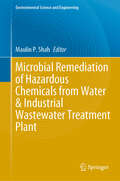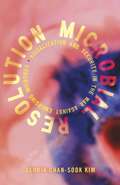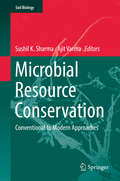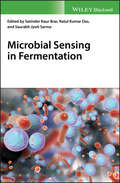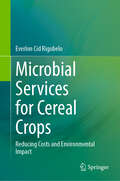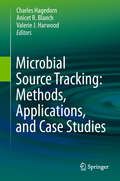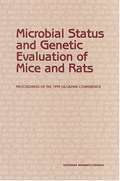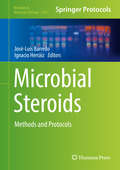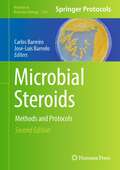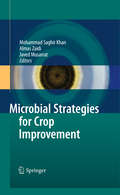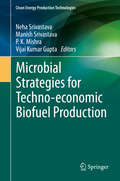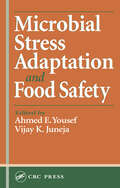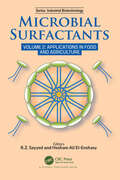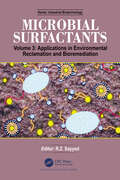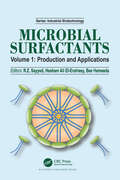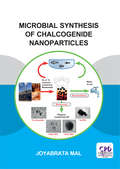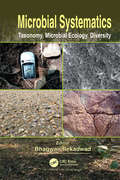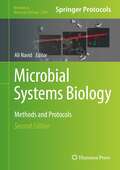- Table View
- List View
Microbial Remediation of Hazardous Chemicals from Water & Industrial Wastewater Treatment Plant (Environmental Science and Engineering)
by Maulin P. ShahThis book discusses the new and emerging innovative trends in the bioremediation of hazardous pollutants found in wastewater. It also includes the fate of pollutants produced after the treatment process both at the laboratory scale and at the industrial scale. The book intrusively explores the unique biological aspects of the wastewater treatment process and highlights the advantages they provide for engineering applications in the industries. Each chapter covers a different biological-based approach and examines the basic principles, practical applications, recent breakthroughs, and associated limitations. It presents an array of cutting-edge wastewater treatment research and thereafter its applications in treatment, remediation, sensing, and pollution prevention processes. The biological process for application in wastewater research has a significant impact on maintaining the long-term quality, availability, and viability of water. This book elucidates the technologies of biological wastewater treatment processes. The biological processes presented in wastewater treatment processes include (1) bioremediation of wastewater that includes aerobic treatment (oxidation ponds, aeration lagoons, aerobic bioreactors, activated sludge, percolating or trickling filters, biological filters, rotating biological contactors, biological removal of nutrients) and anaerobic treatment (anaerobic bioreactors, anaerobic lagoons); (2) phytoremediation of wastewater that includes constructed wetlands, rhizofiltration, rhizodegradation, phytodegradation, phytoaccumulation, phytotransformation, and hyperaccumulators; and (3) mycoremediation of wastewater. The book describes a broad area of biological processes and water research which are considered key components for advanced water purification. It also includes the desalination technologies that remove, reduce, or neutralize water contaminants that threaten human health and/or ecosystem productivity and integrity.
Microbial Resolution: Visualization and Security in the War against Emerging Microbes (Proximities)
by Gloria Chan-Sook KimAn interdisciplinary study charting the war against microbial futures leads to a new theory of contemporary vision and visuality In 1989, a group of U.S. government scientists met to discuss some surprising findings: new diseases were appearing around the world, and viruses that they thought long vanquished were resurfacing. Their appearance heralded a future perpetually threatened by unforeseeable biological risks, sparking a new concept of disease: the &“emerging microbe.&” With the Cold War nearing its end, American scientists and security experts turned to confront this new &“enemy,&” redirecting national security against its risky horizons. In order to be fought, emerging microbes first needed to be made perceptible; but how could something immaterial, unknowable, and ever mutating be coaxed into visibility, knowability, and operability? Microbial Resolution charts the U.S.-led war on the emerging microbe to show how their uncertain futures were transformed into objects of global science and security. Moving beyond familiar accounts that link scientific knowledge production to optical practices of visualizing the invisible, Gloria Chan-Sook Kim develops a theory of &“microbial resolution&” to analyze the complex problematic that arises when dealing with these entities: what can be seen when there is nothing to see? Through a syncretic analysis of data mining, animal-tracking technologies, media networks, computer-modeled futures, and global ecologies and infrastructures, she shows how a visual impasse—the impossibility of seeing microbial futures—forms the basis for new modes of perceiving, knowing, and governing in the present. Timely and thought provoking, Microbial Resolution opens up the rich paradoxes, irreconcilabilities, and failures inherent in this project and demonstrates how these tensions profoundly animate twenty-first-century epistemologies, aesthetics, affects, and ecologies.
Microbial Resource Conservation: Conventional to Modern Approaches (Soil Biology #54)
by Ajit Varma Sushil K. SharmaThis book covers broad areas in the conservation of microorganisms. It addresses the short, medium and long-term preservation of agriculturally important microorganisms, as well as culture collections and their roles. The respective chapters address topics such as conventional approaches to bacterial, fungal and algal preservation, as well as methods and strategies for preserving recalcitrant microorganisms. Readers will also find the latest insights into the preservation of vesicular-arbuscular (VA) fungi and ecology, diversity and conservation of endophytes, and entamopathogenic fungi. Microbes of animal and dairy origin, their preservation and biosafety issues are also explored. Microorganisms are the silent and unseen majority of life on Earth, and are characterized by a high degree of genetic and metabolic diversity. It is well documented that no branch of science or society is unaffected by microbial interventions. Researchers have documented microorganisms from such extreme and unique environments as deserts and hydrothermal vents, and with specific traits that are currently being exploited in agriculture, industry, medicine and biotechnological applications. Such great potential can only be found in microorganisms. The aim of this book – the first entirely devoted to the conservation of microorganisms, and to regulatory mechanisms for access and benefits sharing as per Biological Diversity (BD) Act 2002 – is to promote awareness of our world’s microbial wealth, and to introduce readers to strategies and methodologies for the conservation of microorganisms, which could ultimately save human life on Earth.
Microbial Sensing in Fermentation: Making Sense Of Applied Parameters
by Satinder K. Brar Ratul K. Das Saurabh J. SarmaA comprehensive review of the fundamental molecular mechanisms in fermentation and explores the microbiology of fermentation technology and industrial applications Microbial Sensing in Fermentation presents the fundamental molecular mechanisms involved in the process of fermentation and explores the applied art of microbiology and fermentation technology. The text contains descriptions regarding the extraordinary sensing ability of microorganisms towards small physicochemical changes in their surroundings. The contributors — noted experts in the field — cover a wide range of topics such as microbial metabolism and production (fungi, bacteria, yeast etc); refined and non-refined carbon sources; bioprocessing; microbial synthesis, responses and performance; and biochemical, molecular and extra/intracellular controlling. This resource contains a compilation of literature on biochemical and cellular level mechanisms for microbial controlled production and includes the most significant recent advances in industrial fermentation. The text offers a balanced approach between theory and practical application, and helps readers gain a clear understanding of microbial physiological adaptation during fermentation and its cumulative effect on productivity. This important book: Presents the fundamental molecular mechanisms involved in microbial sensing in relation to fermentation technology Includes information on the significant recent advances in industrial fermentation Contains contributions from a panel of highly-respected experts in their respective fields Offers a resource that will be essential reading for scientists, professionals and researchers from academia and industry with an interest in the biochemistry and microbiology of fermentation technology Written for researchers, graduate and undergraduate students from diverse backgrounds, such as biochemistry and applied microbiology, Microbial Sensing in Fermentation offers a review of the fundamental molecular mechanisms involved in the process of fermentation.
Microbial Services for Cereal Crops: Reducing Costs and Environmental Impact
by Everlon Cid RigobeloThis book will focus on microbial services as an excellent strategy to face the current challenge of global agriculture, collecting the principal studies that used microbial services for improving cereal production, such as rice, beans, maize and wheat. This book will address studies and discussion about the bacterial world inside the plant; phytostimulator microorganisms; promotion of maize growth for biocontrol; filamentous fungi as plant growth promoters; mycorrhiza; sustainable agriculture effects on the microbiome; humic substances in combination with plant growth-promoting bacteria in rice; and the changes in plant metabolome induced by microorganisms under environmental stress.
Microbial Source Tracking: Methods, Applications, and Case Studies
by Valerie J. Harwood Anicet R. Blanch Charles HagedornUnderstanding the origin of fecal pollution is essential in assessing potential health risks as well as for determining the actions necessary to remediate the quality of waters contaminated by fecal matter. As a result, microbial source tracking (MST) has emerged as a field that has evolved and diversified rapidly since the first approaches were described only a decade ago. In response to the emergence of MST, there have been three large multi-laboratory method comparison studies (two in the US and one in Europe), plus numerous workshops, book chapters, and review articles dedicated to synthesizing information on the topic. Furthermore, a federal (USEPA) guide document describing the uses and limitations of MST methods was published in 2005, and a book dedicated to MST as an emerging issue in food safety was published in 2007. These documents provide a collective body of literature on MST that is both conflicting and complementary, often repetitious, and difficult to condense and interpret. In addition, it does not reflect the current diversity of MST approaches with different organisms, newer methodologies such as quantitative PCR, and anthropogenic chemicals, nor does it embrace the scope of MST research being conducted around the world. The three editors of the book, all with extensive MST expertise, have developed chapters and invited authors who reflect the rich diversity and truly international scope of MST. The unifying theme throughout the book is the design of more standardized approaches to MST that include performance criteria (regardless of method or organism), plus recommendations for field study design and MST implementation. The editors intend that this book will serve as a valuable reference for all those who are involved with
Microbial Status and Genetic Evaluation of Mice and Rats: Proceedings of the 1999 US/Japan Conference
by International Committee of the Institute for Laboratory Animal ResearchA report on the PROCEEDINGS OF THE 1999 US/JAPAN CONFERENCE
Microbial Steroids: Methods and Protocols (Methods in Molecular Biology #1645)
by José-Luis Barredo Ignacio HerráizThis volume provides practical experimental laboratory protocols for a wide range of steroid bioconversions. The chapters in this book cover topics such as bioconversions and chemical synthesis pathways; strain characterization; bioconversion from sterols to androstenedione and androstadienedione; steroid hydroxylations; biocatalysis; and downstream processes to purify steroid intermediates. Written in the highly successful Methods in Molecular Biology series format, chapters include introductions to their respective topics, lists of the necessary materials and reagents, step-by-step, readily reproducible laboratory protocols, and tips on troubleshooting and avoiding known pitfalls. Comprehensive and thorough, Microbial Steroids: Methods and Protocols is a valuable resource for laboratory and industrial professionals. It is also useful for graduate students studying biotechnology, microbiology, genetics, and molecular biology.
Microbial Steroids: Methods and Protocols (Methods in Molecular Biology #2704)
by José-Luis Barredo Carlos BarreiroThis detailed volume explores experimental laboratory procedures for a wide range of steroid bioconversions. After an overview on the current trends and perspectives, the book continues with sections covering microbial screening and synthetic biology applied to microorganisms able to catabolize sterols, methods on strain characterization, including omics and biochemical analyses, methods of fermentation and biocatalysis for steroids production, as well as a chapter on the medical use of glucocorticoids in cancer patients. Written for the highly successful Methods in Molecular Biology series, chapters include introductions to their respective topics, lists of the necessary materials and reagents, step-by-step and readily reproducible laboratory protocols, and tips on troubleshooting and avoiding known pitfalls. Authoritative and practical, Microbial Steroids: Methods and Protocols, Second Edition serves as an ideal reference source for laboratory and industrial professionals, as well as for students in a wide array of biological disciplines.
Microbial Strategies for Crop Improvement
by Javed Musarrat Almas Zaidi Mohammad Saghir KhanThis book presents the multidisciplinary nature and the many fascinating aspects of microbiological approaches for crop improvement in both conventional and stressed soils where quality and safety are the key concerns. The major goal is to provide a cross-section of the latest accomplishments and envisaged future directions in these areas. It gives a holistic view of the basic concepts and practical utility of microbes and thus presents an all-inclusive contemporary treatise on strategic aspects of the diverse microbial communities providing solutions to oodles of customary agronomic problems. This book benefits people working in the area of agronomy, biotechnology, environmental biology, microbiology, plant physiology, plant protection and soil science. The contributions by eminent academicians and professionals ensure a good equilibrium between theory and practice without compromising the basic conceptual framework of the concerned subject.
Microbial Strategies for Techno-economic Biofuel Production (Clean Energy Production Technologies)
by P. K. Mishra Vijai Kumar Gupta Neha Srivastava Manish SrivastavaBiofuels are one of the most sustainable options when it comes to renewable energy sources to replace fossil fuels. Biotechnological processes, such as microbial fermentation, are used to produce energy from waste biomass by converting organic substrates into biofuels. This book discusses practices to improve and enrich various microbial communities in order to enhance sustainable and economical biofuel production. It also evaluates various strategies to develop potential microorganisms and microbial consortia to produce highly efficient biofuels at a relatively low cost.
Microbial Strategies for Vegetable Production
by Almas Zaidi Mohammad Saghir KhanThis book provides a comprehensive information on basic and applied concepts of microbesial strategies adopted for the improvement of vegetables grown in various production systems. The beneficial role of soil microbes including plant growth promoting rhizobacteria (PGPR), nitrogen fixers, and phosphate-solubilizing bacteria in the improvement of vegetables grown both in normal and contaminated soils is discussed. The role of PGPR in tomato production is dealt separately. The impact of heavy metals on different vegetables and abatement of metal toxicity following metal tolerant PGPR and their consequential impact on vegetables grown in metal polluted soil is discussed. Moreover, recent advances in the management of vegetable diseases employing PGPR are addressed. This volume is therefore of special interest to both academics, professionals and practitioners working in the field of vegetable farming/horticulture, microbiology and plant protection sciences.
Microbial Stress Adaptation and Food Safety
by Vijay K. Juneja Ahmed E. YousefThe first book to address the subject, Microbial Stress Adaptation and Food Safety emphasizes the implications of stress adaptation and its consequences for food safety. It covers the basic science, kinetics, mechanisms, assessment, and control of stress adaptation and its impact on the safety of foods produced by minimal processing or non-thermal technologies. World renowned experts in the field provide detailed accounts of problems associated with stress adaptation and suggest practical solutions for overcoming these problems.
Microbial Stress Tolerance for Biofuels
by Zonglin Lewis LiuThe development of sustainable and renewable biofuels is attracting growing interest. It is vital to develop robust microbial strains for biocatalysts that are able to function under multiple stress conditions. This Microbiology Monograph provides an overview of methods for studying microbial stress tolerance for biofuels applications using a systems biology approach. Topics covered range from mechanisms to methodology for yeast and bacteria, including the genomics of yeast tolerance and detoxification; genetics and regulation of glycogen and trehalose metabolism; programmed cell death; high gravity fermentations; ethanol tolerance; improving biomass sugar utilization by engineered Saccharomyces; the genomics on tolerance of Zymomonas mobilis; microbial solvent tolerance; control of stress tolerance in bacterial host organisms; metabolomics for ethanologenic yeast; automated proteomics work cell systems for strain improvement; and unification of gene expression data for comparable analyses under stress conditions.
Microbial Styrene Degradation
by Dirk TischlerThis book describes the complex processes involved in styrene degradation by microbes, including highly adaptive microorganisms, the various enzymes involved in styrene biodegradation, new styrene-catabolic routes, novel regulatory mechanisms, and the genes coding for styrene metabolizing enzymes. Numerous biotechnological applications are discussed, such as the development of sustainable eco-friendly technologies as well as the use of styrene degrading microorganisms and their enzymes as a rich resource for biotechnology.
Microbial Surfactants in Pharmaceuticals and Cosmetics
by R. Z. Sayyed Shilpa MujumdarBiosurfactants and bioemulsifiers are considered green molecules as they are produced from microbes and are easily degradable as compared to surfactants. They are suitable due to properties such as low toxicity, tolerance to a wide-range pH level and temperature, high surface activity, biodegradability, excellent emulsifying and demulsifying ability. While, caution and care should be exercised in its widespread usage, they are likely to replace chemical surfactants.The book focuses on biosurfactant production from various bacteria, diversity of biosurfactant producing bacteria, and the industrial need of biosurfactants. Fields such as pharmacy, medicine, and cosmetics are covered. It is presented in an easy-to-understand manner, and is well illustrated, and comprises protocols and recent data on the production, formulation and commercialization and other aspects of biosurfactants and bioemulsifiers.
Microbial Surfactants: Volume 2: Applications in Food and Agriculture (Industrial Biotechnology)
by R. Z. SayyedBiosurfactants are surface-active biomolecules produced by a wide variety of microorganisms. They can be produced from renewable sources, and possess high surface activity, high specificity, low toxicity, tolerance to pH, temperature and ionic strength, biodegradability, excellent emulsifying and demulsifying ability and antimicrobial activity. Biosurfactants have found applications in several industries including organic chemicals, petrochemicals, mining, metallurgy (mainly bioleaching), agrochemicals, fertilizers, foods, beverages, cosmetics, pharmaceuticals and many others. The main aim of this volume is to highlight concepts, classifications, production and applications of microbial surfactants in food and agriculture. The book provides a comprehensive coverage of fermentation, recovery, genomics and metagenomics of biosurfactant production. It is presented in an easy-to-understand manner, and includes protocols, figures, and recent data on the industrial demand market and economics, and the production of biosurfactants from novel substrates are particularly worthwhile additions. The volume will be useful for students, researchers, teachers, and entrepreneurs in the area of microbial biosurfactants and their applications in food and agriculture.
Microbial Surfactants: Volume 3: Applications in Environmental Reclamation and Bioremediation (Industrial Biotechnology)
by R. Z. SayyedBiosurfactants are the surface-active biomolecules produced by a wide range of microorganisms. The enormous diversity of biosurfactants make them an interesting group of molecules. Biosurfactants, are less toxic, eco-friendly and possess amphiphatic structure. Due to these and many other useful properties, biosurfactants play a significant role in oil recovery, waste utilization and bioremediation of industrial effluents; hydrocarbons, pesticides and toxic heavy metals and many other hazardous substances. Biosurfactants offer numerous advantages over chemical surfactants. They are environmentally friendly, can be produced from natural sources, less toxic, possess high specificity, have better foaming and emulsifying properties and survive extreme conditions such as high temperatures, extreme pH and salinity. They are cheaper as they can be produced from industrial waste and from by-products as opposed to chemical surfactants. This volume comprises concepts, classification, production and applications of biosurfactants in oil recovery, environment and clean up, etc. It is an excellent literature on fermentation, recovery, genomics and metagenomics of biosurfactant production. It is presented in an easy-to-understand manner, with well-illustrated diagrams, protocols, figures, and recent data on the production, formulation and commercialization and other aspects of biosurfactants. As such, the book will be useful for students, researchers, teachers, and entrepreneurs in the area of PGPR and its allied fields.
Microbial Surfactants: Volume I: Production and Applications (Industrial Biotechnology)
by Hesham All El-EnshasyBiosurfactants are the surface-active biomolecules produced by microorganisms. Biosurfactants have gained commercial significance due to their unique properties, such as high surface activity, high specificity, low toxicity, tolerance to pH, temperature and ionic strength, biodegradability, excellent emulsifying and demulsifying ability, antimicrobial activity, ability to work under extreme conditions, and relative ease of preparation. Biosurfactants are used in several industries, including organic chemicals, petroleum, petrochemicals, mining, metallurgy (mainly bioleaching), agrochemicals, fertilizers, foods, beverages, cosmetics, pharmaceuticals and many others. The aim of this book is to highlight key aspects from basics to advanced concepts, classifications, production and applications in various fields such as agriculture, health, bioremediation, industries, pharmaceutical, oil recovery, environment, and nanotechnology. It also serves as an excellent and expansive literature on fermentation, recovery, genomics, and metagenomics of biosurfactant production. The book focuses on the biosurfactant production from bacteria, the diversity of biosurfactant producing bacteria, and industrial need of biosurfactant.
Microbial Symbionts and Plant Health: Trends and Applications for Changing Climate (Rhizosphere Biology)
by Swarnendu Roy Piyush Mathur Rupam KapoorThis book provides a comprehensive understanding of the complex relationship between microbial symbionts and plants in the era of climate change. It focuses on the plant microbiome associated with different plant organs like roots, leaves, stems, fruit, and seeds, and showcases their significant role in the enhancement of crop yield and protection in a sustainable manner. Concomitantly, acumens to the most emerging trends in plant microbial research that includes rhizosphere engineering and metagenomics are also covered in this title. The association of microbial symbionts with the host offers a wide advantage in terms of acclimatization to varied environmental conditions. A large number of microbes such as cyanobacteria, PGPR, endophytes, and AMF have been shown to improve plant growth and production under the effect of various abiotic and biotic stresses. These microbial symbionts secrete several secondary metabolites, signaling molecules, and hydrolytic enzymes that play a multifarious role in improving plant growth and yield. Moreover, the symbionts have been known to regulate the host responses at the molecular level. Bioprospecting these microbial symbionts will provide an alternative to the chemical-based fertilizers and pave the path for the development of biofertilizers. The book is a suitable reading material for undergraduate and postgraduate students, researchers, and scientists working in the field of agricultural biotechnology, microbiology, mycology and plant pathology, and allied fields of plant and microbial sciences. The book in this context attempts to provide an integrative and exhaustive study as well as research material that would help the scientific community in wide respect.
Microbial Synthesis of Chalcogenide Nanoparticles: Combining Bioremediation and Biorecovery of Chalcogen in the Form of Chalcogenide Nanoparticles (IHE Delft PhD Thesis Series)
by Joyabrata MalRecent years have seen a growing interest in the application of chalcogenide nanoparticles (NPs), e.g. Se, Te, CdSe and CdTe NPs, in various industrial sectors including energy, petroleum refining and in the field of biology and medicine. Moreover, due to the high toxicity of chalcogen oxyanions, their release into the environment is of great concern. Thus, emphasis was given in this study on the development of a novel microbial synthesis process of chalcogenide NPs by combining biological treatment of Se/Te containing wastewaters with biorecovery in the form of Se NPs, Te NPs and CdSe NPs. Enrichment of Se-oxyanion reducing microorganisms was carried out to simultaneously remove selenite (Se(IV)) and cadmium (Cd(II)) from wastewaters by combining bioremediation of toxic Se-rich wastewater with the biorecovery of Se as CdSe NPs. The results showed compositional changes in the extracellular polymeric substances (EPS) matrix of the anaerobic granular sludge upon exposure to Cd(II) and Se(IV) and identified the roles of EPS fractions in the biogenesis of CdSe NPs. Besides, it was found that the EPS on the surface of the biogenic Se NPs play a major role in lowering the bioavailability and toxicity of biogenic Se(0) compared to chemogenic Se(0) NPs. An upflow anaerobic sludge blanket (UASB) reactor was used for the first time to continuously remove tellurite from wastewater and recover biogenic Te(0).
Microbial Systematics: Taxonomy, Microbial Ecology, Diversity
by Bhagwan RekadwadThis book presents recent scientific investigations in microbial ecology and systematics. Advanced microbial science investigations employ the latest technologies for research in microbiology and microbial applications. The book has complete information on classical microbiology techniques for assessment of the composition of microbial diversity assessment, advancement in next-generation technology, advantages of microbial products in sustainable developments and their application for societal benefits. Current research on microorganisms is presented as a perfect book for studies on "Microbial Systematics". This book will serve as an important resource for practising research and review for the scientific community.
Microbial Systems Biology
by Ali NavidSystems biology is the study of interactions between assorted components of biological systems with the aim of acquiring new insights into how organisms function and respond to different stimuli. Although more and more efforts are being directed toward examining systems biology in complex multi-cellular organisms, the bulk of system-level analyses conducted to date have focused on the biology of microbes. In, Microbial Systems Biology: Methods and Protocols expert researchers in the field describe the utility and attributes of different tools (both experimental and computational) that are used for studying microbial systems. Written in the highly successful Methods in Molecular BiologyTM series format, chapters include introductions to their respective topics, lists of the necessary materials and reagents, step-by-step, readily reproducible laboratory protocols, and key tips on troubleshooting and avoiding known pitfalls. Authoritative and practical, Microbial Systems Biology: Methods and Protocols introduces and aids scientists in using the various tools that are currently available for analysis, modification and utilization of microbial organisms.
Microbial Systems Biology: Methods and Protocols (Methods in Molecular Biology #2349)
by Ali NavidThis second edition provides new and updated chapters describing the utility and attributes of different tools that are used for studying microbial systems. Chapters detail a number of methods, including in silico system level analyses by MetaFlux, Kbase genome-scale model builder, COBRA toolbox, NanoSIP, and PAMMS. Written in the highly successful Methods in Molecular Biology series format, chapters include introductions to their respective topics, lists of the necessary materials and reagents, step-by-step, readily reproducible laboratory protocols, and tips on troubleshooting and avoiding known pitfalls. Authoritative and cutting-edge, Microbial Systems Biology: Methods and Protocols, Second Edition aims to introduce and aid scientists in using the various tools that are currently available for analysis, modification, and utilization of microbial organisms.
Microbial Technologies for Wastewater Recycling and Management: Recent Trends, Challenges, and Perspectives
by Kumar VineetThis book introduces the innovative and emerging microbial technologies for the treatment, recycling, and management of industrial, domestic, and municipal water and other wastewater in an environment-friendly and cost-effective manner. It discusses existing methods and technologies, up-gradation of existing technologies, and new technologies. It also highlights opportunities in the existing technologies along with industrial practices and real-life case studies.
